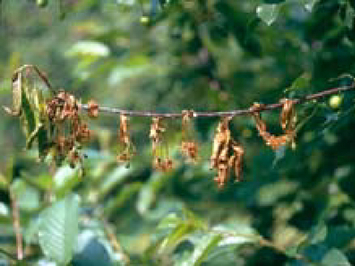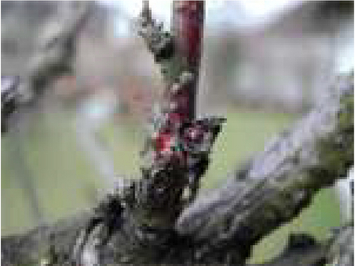Monilinia
Profile
The causal agents of monilinia disease are the fungi Monilinia fructigena and Monilinia laxa, which can cause severe damage in pome and stone fruit crops. Tip drought, twig dieback, and the resulting gum flow can cause major crop losses in stone fruit. Monilia fruit rot is also one of the most common storage diseases of fruit.
Damage symptoms



The symptoms of damage can occur on different parts of the plant:
Tip drought occurs more frequently on stone fruit. The leaves and flowers at the shoot and branch tips wilt abruptly, turn brown to gray and dry out. Occurs especially on sour cherries (e.g. morello cherries) and apricots, but more rarely on apples (e.g. James Grieve or Alkmene).
Bark blight and twig dieback occur when infections spread from the fruit to the shoots. There is dieback that looks like frost damage.
Fruit rot: brown rot forms on the fruit, which rapidly increases in size and can encompass the entire fruit. Brown or gray spore deposits arranged in concentric rings develop there ("cushion mold"). Affected fruits either fall off or dry up and remain on the tree as fruit mummies.
In storage (under light exclusion), the so-called "black rot" develops in apples, in which the entire fruit skin appears leathery and glossy black.
Host plants
Infections with Monilinia are possible in all stone and pome fruit species, with blossom infections and tip drought playing a greater role in sour cherry, apricot, cherry, peach, plum, and almond than in pome fruit. Fruit rot, however, is of major importance in all stone fruit and pome fruit species.
Propagation and transmission
The pathogens overwinter on fruit mummies or in diseased twigs in the form of permanent spores. At the end of winter, spore deposits are formed, from which spores (conidia) are released. Insects or wind transport them to the flower organs. In humid flowering weather, infections can occur from the opening of the first flowers until the end of flowering.
Fruit infection occurs exclusively through fruit touching each other or through wounds (fine cracks in the fruit skin are sufficient). On freshly stored fruit, the rot continues to develop and it spoils within a few days.
Prevention and control
- Cut off infested shoot tips before flowering
- Remove and destroy rotting fruit continuously
- Avoid injuries:
- Control animal pests (e.g. codling moth, plum moth, cherry fly, sawfly, wasps) and scab
- Handle fruit carefully during harvesting and sorting
- Do not store diseased fruit
- Use approved plant protection products on susceptible varieties (to avoid resistance, a change of active ingredient is recommended; see list of plant protection products approved in Austria)
- Blossom monilia: shortly before rainfall, carry out preventive treatments during blossoming
- Fruit monilia: the more ripe the fruits, the more sensitive they become, recommended treatments during the last four weeks before harvest (observe waiting periods!)
Last updated: 11.04.2023
automatically translated